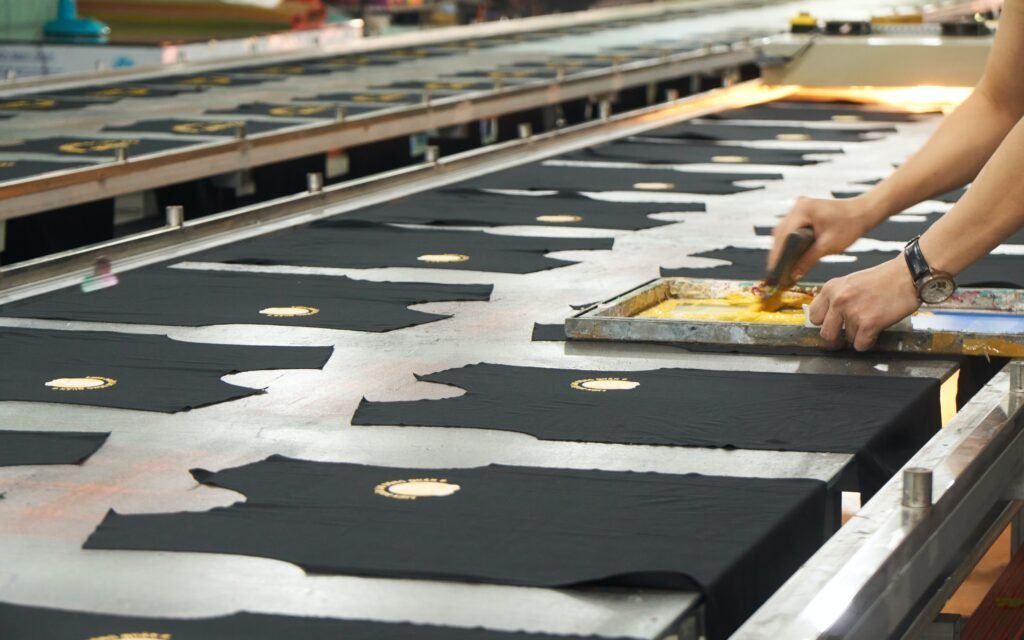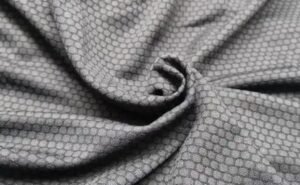Speaking of clothing production, printing is an important step we cannot ignore. Screen printing is one of the most commonly used printing method in the apparel industry. As designers, we need to know about different printing methods. This article will introduce the basic knowledge of screen printing to you. We hope to increase your understanding of screen printing after you read this article.

Definition of screen printing?
Screen printing refers to the use of a screen as a plate base, and through the photopolymerization method, a printing plate with graphics is made. Screen printing consists of five main elements, screen printing plate, squeegee, ink, printing table and substrate. Screen printing utilizes the basic principle that the graphic portion of the printing plate is permeable to ink and the non-graphic portion of the printing plate is not permeable to ink. People pour ink into one end of the printing plate poured and use the squeegee to add pressure on the printing plate, and move the squeegee towards the other end of the printing plate at a constant speed. The ink will be squeezed to the clothes during that process. In China, silk screen printing has a history of more than 2,000 years. This printing method existed as early as the Qin and Han Dynasties.
Benefits of screen printing?
As we all know, screen printing has many benefits. That’s why it is one of the most commonly used printing methods in this industry. Below are the four benefits of screen printing.
1. Screen printing can be used on different materials.
Many printing methods can only print on flat substrates. Screen printing can not only print on flat surfaces, but also on curved surfaces, spherical surfaces and concave or convex surfaces. Besides, screen printing can print not only on hard materials, but also on soft materials, regardless of the texture of the substrate. Therefore, it can be said that screen printing is very adaptable and has a wide range of applications.
2. The image printed using screen printing is more vivid.
The thickness of ink layer of other printing method is generally 5 microns. The thickness of ink layer of flexographic printing is 10 microns. Meanwhile, the thickness of ink layer of screen printing exceeds 30 microns. Therefore, images printed using screen printing is more vivid, which other printing methods cannot compare.
3. Patterns printed using screen printing have strong light resistance.
Screen printing can use all kinds of inks and coatings, not only slurries, adhesives and pigments, but also pigments with coarse particles. In addition, screen printing inks are easy to mix. For example, light-resistant pigments can be added directly to the ink. Therefore, screen printing products have the great advantage of high light resistance. The light resistance of screen-printing products is stronger than those using other printing methods.
4. Screen printing has large printing area.
Printing area of other printing methods is limited due to mechanical equipment. Screen printing has large printing area. Today, the printing area of screen printing is up to 3 meters by 4 meters, and it can be even larger.
The above four points are the advantages of screen printing. Understand these benefits, you can avoid the shortcomings and highlight the advantages of screen printing, thus achieving a more ideal printing result.
Screen printing in the apparel industry.

We all wear clothes with beautiful patterns in our daily lives. However, not many people know exactly how the patterns printed on our clothes. In fact, we mostly use screen printing method to print the patterns on the clothes. The application of screen printing in the apparel industry is mainly through two forms: watermark screen printing and offset screen printing.
If we use watermark screen printing, as long as the paint is evenly blended, the printed garment will be soft to touch. Due to the paint of this printing method is mainly composed of water, and water is a colorless and transparent liquid. So, this method is only suitable for printing on some light-colored clothing. The effect will be relatively poor if we use this method on dark clothes.
Offset screen printing is more commonly used on dark fabrics. You can use this printing method to print any pattern you want on clothes with any color. Its disadvantage is that clothes using this kind of screen-printing method feel a little stiff.
Process of screen printing?
There are different methods of screen printing, but they all involve roughly the same process. We will discuss the seven steps of screen printing below。
Step 1: Designing and making the mold
First, the designers have to print their designs onto a transparent acetate membrane through a printer. Then, he should make a mold from the acetate membrane with the printed designs.
Step 2: Preparing the Mesh Screen
Next, the designer should select a mesh screen that will meet the design requirements and determine the texture of the garment fabric. Then, apply a light-reactive emulsion to the mesh screen so that it will harden when exposed to bright light.
Step 3: Exposing the acetate membrane
The acetate membrane is then placed on a screen coated with the emulsion and the entire product is then exposed to very bright light. The light will harden the emulsion. If the final design contains multiple colors, a separate screen must be used to apply each layer of ink. To create a multi-colored product, the designer must align each stencil perfectly to ensure the final design is seamless.
Step 4: Wash off the emulsion and form the stencil
After exposing the screen for a certain amount of time, the uncovered screen area will harden. We need to carefully wash off any unhardened emulsion. This will leave a clear branding of the design on the screen to allow the ink to pass through. The screen will then be dried and the designer will make any necessary touch-ups or corrections to make the imprint match the original design as closely as possible. Then, the mold will be ready to use.
Step 5: Preparing to Print
The screen is then placed on the printer and the item or garment to be printed is placed flat on the printing plate below the screen. There are many choices of printing presses, including manual and automatic presses, but most modern commercial printers are automatic rotary carousel presses because they allow several different screens to be used at the same time. For color printing, this type of printer can also be used to apply individual layers of color in quick succession.
Step 6: Press the ink through the screen onto the garment
The screen is lowered onto the printing plate. Add ink to the top of the screen and press the ink through the open area of the stencil to emboss the design onto the product below.
Step 7: Drying the product
The printed garment is then passed through a dryer which cures the ink and produces a smooth, colorfast finish. Before the final product is passed on to the customers, it should be inspected and thoroughly cleaned to remove all residue.
Conclusion
To sum up, as one of the most commonly used printing method in apparel industry, screen printing has many benefits. However, there are other printing methods as well. As someone working in the clothing industry, we should learn about different printing methods and choose the most suitable one. Should you have any more questions about screen printing or other printing methods, please do not hesitate to contact us. As a garment factory with 15 years of experience in garment manufacturing, we are confident and strong enough to help take your project or brand to the next level.







